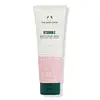What's inside
What's inside
 Key Ingredients
Key Ingredients

 Benefits
Benefits

 Concerns
Concerns

 Ingredients Side-by-side
Ingredients Side-by-side

Water
Skin ConditioningGlycine Soja Oil
EmollientCoco-Glucoside
CleansingHydroxypropyl Starch Phosphate
Coco-Betaine
CleansingSodium Methyl Cocoyl Taurate
CleansingSodium Chloride
MaskingAcrylates/C10-30 Alkyl Acrylate Crosspolymer
Emulsion StabilisingPhenoxyethanol
PreservativeTocopheryl Acetate
AntioxidantSodium Benzoate
MaskingSodium Gluconate
Skin ConditioningParfum
MaskingSodium Hydroxide
BufferingRubus Idaeus Seed Oil
EmollientBenzyl Benzoate
AntimicrobialBenzyl Alcohol
PerfumingGeraniol
PerfumingLinalool
PerfumingTocopherol
AntioxidantLimonene
PerfumingGlycerin
HumectantCitric Acid
BufferingCI 14700
Cosmetic ColorantCI 19140
Cosmetic ColorantWater, Glycine Soja Oil, Coco-Glucoside, Hydroxypropyl Starch Phosphate, Coco-Betaine, Sodium Methyl Cocoyl Taurate, Sodium Chloride, Acrylates/C10-30 Alkyl Acrylate Crosspolymer, Phenoxyethanol, Tocopheryl Acetate, Sodium Benzoate, Sodium Gluconate, Parfum, Sodium Hydroxide, Rubus Idaeus Seed Oil, Benzyl Benzoate, Benzyl Alcohol, Geraniol, Linalool, Tocopherol, Limonene, Glycerin, Citric Acid, CI 14700, CI 19140
Water
Skin ConditioningCalamine
AbsorbentGlycerin
HumectantOlive Oil PEG-7 Esters
EmollientLactic Acid
BufferingSodium Lauroyl Methyl Isethionate
CleansingPhenoxyethanol
PreservativeXanthan Gum
EmulsifyingCocamidopropyl Betaine
CleansingSodium Methyl Oleoyl Taurate
CleansingHydrolyzed Whey Protein
Skin ConditioningSodium Cocoyl Isethionate
CleansingEthylhexylglycerin
Skin ConditioningTrisodium Ethylenediamine Disuccinate
Sodium Benzoate
MaskingWater, Calamine, Glycerin, Olive Oil PEG-7 Esters, Lactic Acid, Sodium Lauroyl Methyl Isethionate, Phenoxyethanol, Xanthan Gum, Cocamidopropyl Betaine, Sodium Methyl Oleoyl Taurate, Hydrolyzed Whey Protein, Sodium Cocoyl Isethionate, Ethylhexylglycerin, Trisodium Ethylenediamine Disuccinate, Sodium Benzoate
Ingredients Explained
These ingredients are found in both products.
Ingredients higher up in an ingredient list are typically present in a larger amount.
Glycerin is already naturally found in your skin. It helps moisturize and protect your skin.
A study from 2016 found glycerin to be more effective as a humectant than AHAs and hyaluronic acid.
As a humectant, it helps the skin stay hydrated by pulling moisture to your skin. The low molecular weight of glycerin allows it to pull moisture into the deeper layers of your skin.
Hydrated skin improves your skin barrier; Your skin barrier helps protect against irritants and bacteria.
Glycerin has also been found to have antimicrobial and antiviral properties. Due to these properties, glycerin is often used in wound and burn treatments.
In cosmetics, glycerin is usually derived from plants such as soybean or palm. However, it can also be sourced from animals, such as tallow or animal fat.
This ingredient is organic, colorless, odorless, and non-toxic.
Glycerin is the name for this ingredient in American English. British English uses Glycerol/Glycerine.
Learn more about GlycerinPhenoxyethanol is a preservative that has germicide, antimicrobial, and aromatic properties. Studies show that phenoxyethanol can prevent microbial growth. By itself, it has a scent that is similar to that of a rose.
It's often used in formulations along with Caprylyl Glycol to preserve the shelf life of products.
Sodium Benzoate is a preservative. It's used in both cosmetic and food products to inhibit the growth of mold and bacteria. It is typically produced synthetically.
Both the US FDA and EU Health Committee have approved the use of sodium benzoate. In the US, levels of 0.1% (of the total product) are allowed.
Sodium benzoate works as a preservative by inhibiting the growth of bacteria inside of cells. It prevents the cell from fermenting a type of sugar using an enzyme called phosphofructokinase.
It is the salt of benzoic acid. Foods containing sodium benzoate include soda, salad dressings, condiments, fruit juices, wines, and snack foods.
Studies for using ascorbic acid and sodium benzoate in cosmetics are lacking, especially in skincare routines with multiple steps.
We always recommend speaking with a professional, such as a dermatologist, if you have any concerns.
Learn more about Sodium BenzoateWater. It's the most common cosmetic ingredient of all. You'll usually see it at the top of ingredient lists, meaning that it makes up the largest part of the product.
So why is it so popular? Water most often acts as a solvent - this means that it helps dissolve other ingredients into the formulation.
You'll also recognize water as that liquid we all need to stay alive. If you see this, drink a glass of water. Stay hydrated!
Learn more about Water